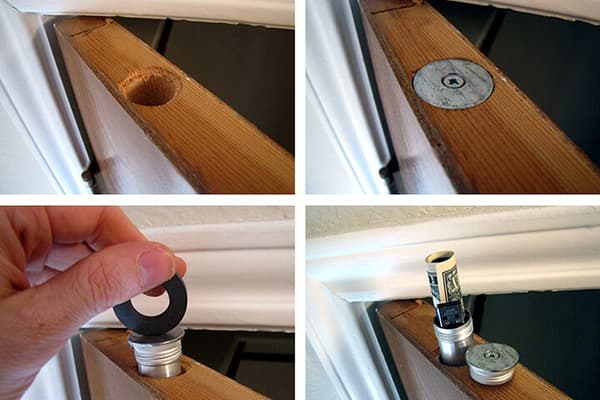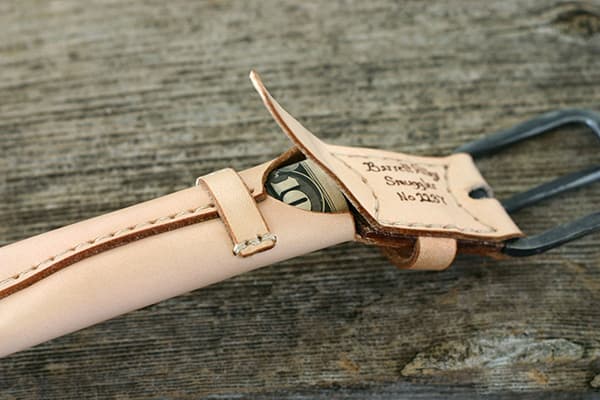What is the best place to hide money at home or on a trip?
Content:
In our century of plastic cards and electronic transfers, the issue of arranging hiding places for money and jewelry still remains relevant. It is not always prudent to keep absolutely all savings on a card or bank account (or there is simply no way to throw them there). And you can’t put jewelry on a card at all. How to hide money in an apartment so as not to worry about their safety?
How to hide the money?
The answer seems simple: reliable, so that no one finds it. But reliable - where is it? It is no secret that the housekeepers know many of the most popular apartment caches among ordinary people, which they gutted in the first place, once in the home of an excommunicated family.
On the net you can find a lot of advice on building reliable secret storage of money, which in fact will be the simplest finds for thieves. Among them, for example:
- dressers cabinets, pillows, mattresses, furniture upholstery;
- drain tanks, ventilation, a place under the sink, toiletries (shaving foam, bottles of fresheners, hair sprays);
- flower pots;
- laminate flooring;
- carpets, sconces, paintings, watches, mirrors hanging on the walls;
- bookshelves;
- TV, computer, set-top box;
- refrigerator, freezer, containers with bulk products, trash bin, oven, microwave.
- obvious caches - caskets, DVD cases, safes.
At first glance, with this approach, there are practically no places left at home that the attackers could not find and tear up. But this is only at first glance. Indeed, in order to hide money or jewelry in the apartment, you need to arrange a cache so that it blends seamlessly with the overall interior and does not look like an obvious cache. Therefore, it is enough just to carefully inspect the apartment, and then think carefully.
If you plan to frequently access the contents of your secret storage, it makes no sense to equip it in the most inaccessible place. Constantly moving cabinets, putting a stepladder or performing some other uncomfortable manipulation, to put it mildly, is unreasonable. But they will certainly be justified if the money is postponed for a long time.
Where to hide money in an apartment or house?
So, if you think about it, you can organize a cache almost anywhere. The main thing is to make it inconspicuous. For example:
- drill (or do it in some other way) a niche for a bundle of notes on the upper and lower edges of the interior door and seal them on top with a suitable veneer or furniture film;
- roll up money with a tube, fasten inside a hollow curtain ledge above the window (a hollow ledge for a bathroom curtain can become the same cachet);
- cavities inside the windowsill, shelving, wall, cut out with your own hands, will not be noticeable and obvious;
- the envelope with money can be attached with adhesive tape from the bottom to the bottom of the bottom drawer of the chest of drawers - even if it is opened several times, they will hardly find such a “bookmark”;
- arrange a false outlet on the wall that is outwardly identical to the other outlets, but it will be inoperative and will hide a niche for banknotes or other valuables.
- wrap money with polyethylene and put inside the comb, between the upper and rubber (with cloves-teeth) parts;
- wrap a pack of notes with polyethylene and hide the drain tank inside the float (usually thieves check only the bottom of the tank meticulously, they’re unlikely to think of opening a plastic spare part), you just need to make sure that the bundle of money is not too heavy,otherwise, the correct mode of draining the water is violated;
- to mount a false pipe in the bathroom, which will lead “from nowhere,” while creating an impression of a worker, while hiding a valuable bundle of money inside;
- remove the cactus from the pot, carefully cut out the cavity of the required size inside it, put a plastic roll with bills there and put the cactus back in its place. Even if they check the pot, they won’t look for money inside the prickly flower;
- remove the upholstery and pull out part of the foam from a sofa or chair. Then, make a slot in an inconspicuous area, inside which to build a niche and hide notes or valuables. The slot will easily close, hiding a cache of bills underneath. Then you need to return the remaining foam and upholstery in place.
If the apartment has false ceilings, then a small niche between the ceiling itself and the plasterboard is also suitable for storing money. It will only be necessary to carefully get between these layers at the place of attachment of the chandelier and leave a “bookmark”. And then close all the seams back.
The refrigerator’s elastic band, which usually hides magnets to ensure a tight closing of the door, is also quite suitable for storing a not very large volume of notes, if you carefully cut it in an inconspicuous place, remove some of the magnets, and then invest in their place. After that, of course, the cut must be repaired.
If there is a desk in the house or apartment (almost certainly), you can leave a few ballpoint pens on it, inside which bills are rolled up with a tube. Thieves are unlikely to be lucky to find the money hidden in this way. Of course, this option is suitable if the amount of money is small, and the bills themselves are large. Otherwise, a whole mountain of office supplies can be suspicious.
Arrange a deceptive maneuver: leave a small part of the money in a safe in a prominent place in the apartment. Having found it, thieves are likely to stop searching and leave the apartment with a safe (they rarely open them in the apartment itself), deciding that this is all your savings.
Where to hide the money on a trip?
We are talking, of course, about the train, because it is here that things and savings most often remain unattended, and the trip takes the longest time.
It all depends on the amount that must be safely transported. If it is small, then it is best to attach money to the body in one of these ways:
- put in a resealable bag and generously secure with a good adhesive;
- put the bills in the boot of the old kapron stocking (or cut it off from the tights) and wrap it around you, tightly tied;
- hem a small pocket for notes under a jeans label;
- sew a pocket on the back of the bra (if the woman carries the savings) and invest in it, firmly gluing or sewing it. Indeed, in the cups of the bra, the attackers will seek profit in the first place, and they will not be stopped by an attempt to resist.
You can also put money at the very bottom of the luggage bag, and it can be put under the seat on the lower shelf (in this case, it is better to travel with a fellow traveler, who can be left to look after things if you need to leave).
A good trick can be accompanied by a money trick: a bundle of counterfeit notes in a cheap wallet. You can put a couple of real pieces of paper of small denomination in it to pull out, for example, for going for food. Thieves will see where the money was pulled from and they will “lead” this particular snag.
Perhaps the most effective and safe way to transport a large amount is to issue a money transfer in your name, which is sent to the destination and then removed at the bank upon arrival.
Perhaps after reading this article, someone will come up with even more ingenious ways to circle thieves around your finger and save your money. The main thing is to make sure that the owner of material assets can, if necessary, get to his nest egg.



Now all the house-owners know where the money-educational program is hidden!
wonderful educational program for the home.